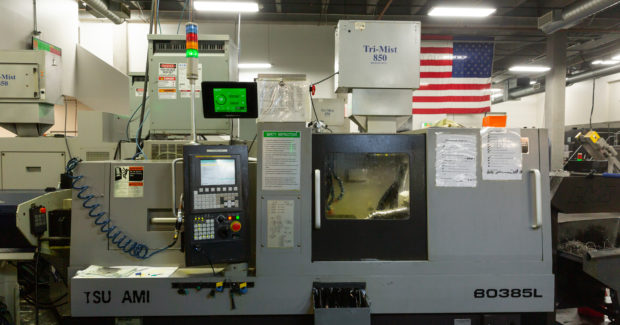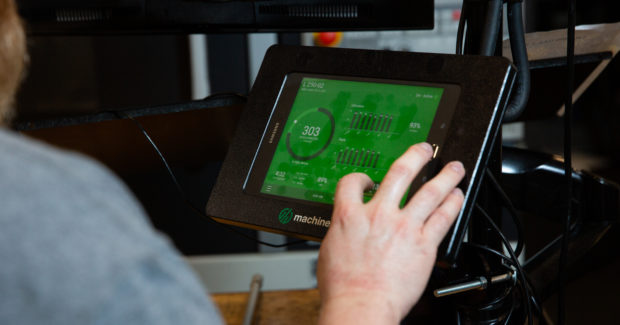We’re One Step Closer to Keeping Production-Disrupting Failures from Ever Happening
An estimated 10% to 20% of tools are changed out too soon to avoid failure during cutting. Edge computing is giving machine tool builders and manufacturers the tool they need to avoid such unnecessary expense.
Posted: April 6, 2020
BY STEPHANIE JOHNSTON
In May 2018, machine tool builder Tsugami/Rem Sales LLC (Windsor, CT) partnered with third-party data-analytics provider MachineMetrics (Northampton, MA) to add remote-monitoring capability to swiss machines sold in North America. As with all monitoring initiatives, the goal is to lower after-sale service costs by troubleshooting machine-related production issues as quickly as possible.
Traditional maintenance programs are based on machine hours or predetermined intervals. Machine builders typically responded after a failure had occurred, with precious production hours – or days – ticking agonizingly by as service teams investigated the problem and waited for replacement parts.
Reducing unplanned downtime is key to profitability. Remote machine monitoring (RMM) helps by collecting and transmitting data to the cloud in real time, enabling machine builders, operators, and shops to respond much more quickly to problems.
The Holy Grail of data is the ability to use it to prevent breakdowns. With predictive maintenance, tool builders can review the data, detect exceptions to historical patterns, and – ideally – service the machine before a occurs. In addition to increasing overall equipment effectiveness (OEE), this saves shops money by eliminating the need to keep replacement parts on hand.
Challenges and Opportunities
Those are upsides of the Industrial Internet of Things (IIoT), but there are other considerations when entering the arena:
- Data integrity due to the remote access.
- Cybersecurity for the network.
- The RMM software’s ability to work with different machine brands; manufacturers not wanting to use different IIoT solutions for different machines.
First, a myriad of PLCs, controllers, and sensors are available to control machines and track variables like temperature, pressure, or strain. RMM systems must be able to connect to a variety of devices with proprietary protocols and data formats.
Second, most manufacturers don’t want software companies integrating with their internal networks via ethernet or Wi-Fi. Machines that weren’t designed to connect to the internet would be exposed over an open network, and many manufacturers don’t have the proper security in place to protect data from being stolen or equipment from being hacked.
Fortunately, manufacturers and machine tool builders have options: Software as a solution (SaaS) providers address these issues by encrypting data and transmitting it independently of a shop’s IT network.
MachineMetrics’s Edge platform, for example, gathers data from a small computer (customers call it “the Little Green Device”) that connects to any modern CNC machine tool control system via an ethernet port. The platform’s software adaptors automatically unlock, map out, collect, and standardize data points (internal sensors, machine status, modes, alarms, overrides, load, speeds, feeds, etc.), bypassing the need for additional sensors and providing a scalable solution customers can easily install and configure. The data is instantly and securely streamed to the cloud via ethernet, Wi-Fi, or cellular communication.
The platform can be installed on older machines by adding the external sensors necessary to connect digital and analog input/output (I/O) that can be configured and managed remotely through a web interface.
So far this year, 70% of MachineMetrics customers installed their system without needing onsite assistance.
The Cloud Gets a Speed-Enhancing Boost
The platform is able to provide virtually instantaneous feedback by using edge computing in addition to cloud computing.
In a traditional Internet of Things (IoT) scenario, a piece of hardware collects, encrypts, and sends data from the machine tool to a central network server – the cloud, which processes the data. The MachineMetrics platform structures and aggregates the data to be presented in easy-to-understand ways — real-time visualization, reporting, diagnostic analytics, etc. – so the user can quickly understand what’s happening and react accordingly.
All that happens very quickly, but not fast enough to produce the information necessary for predictive maintenance activities.
First, it takes time for data to travel from the edge device to the cloud. This slight delay is only milliseconds, but it can be critical for certain decisions, such as stopping a machine tool from breaking.
Secondly, machines produce hundreds of datapoints every millisecond. All that data traveling back and forth between the edge and the cloud strains communication bandwidth.
Rather than constantly sending every piece of data back to the cloud, edge-enabled devices gather and process data in real time right there, at the “edge” of the machine, allowing operators to respond faster and more effectively.
Roughly 20% of MachineMetrics’ customers are machine tool manufacturers, which use historical and real-time data to provide insight into equipment health and condition, warn customers of potential failures, and identify trends that lead to downtime.
Any equipment builder, OEM or distributor can install the device on new and existing machines to connect to the machine’s PLC and any additional sensors into the electrical cabinet. Once installed, the provider adds the device to a list of machine assets accessible via the Service app and associate that machine with the customer’s location. Once the customer powers up the machine, it appears on the provider’s list of assets.
The platform’s analytics engine monitors various data points and initiates an action, such as a text notification, when a limit is exceeded or other anomaly in machine health is detected. A rules engine is provided for deploying monitors based on condition data; machine-learning algorithms detect anomalous behavior.
Data flowing from thousands of connected machines across the U.S. enables MachineMetrics to identify trends and develop standard preventative maintenance and repair schedules. While service teams focus on issues that will immediately impact production, the company keeps an eye on big-picture issues.
Machine builders can use the data to improve customer service in two ways:
- With data showing how their equipment’s being used, they can tweak machine design to improve the customer’s experience.
- To create and deploy optimized preventative maintenance schedules tied to calendar time, usage time, or initiated from machine conditions. Tasks can be assigned through a workflow to track the customer’s maintenance plan to better plan inventory and service needs.
‘Power by the Hour’
Equipment builders are using such capabilities to increase the value of service packages. They could, as Willem Sundblad points out in Forbes, differentiate themselves from the competition by selling uptime instead of machines.
Sundbland gives Rolls-Royce as an example. With the company’s “power-by-the-hour” service agreements, customers pay a fixed rate per operational hour instead of buying the engine. Rolls-Royce, not customers, is responsible for maintenance and provides predictive maintenance services based on insights from IoT-enabled engines that wirelessly send data to four Rolls-Royce centers for monitoring.
Customer Avoids Almost 12,000 Hours of Downtime
One of MachineMetrics’ job shop customers is SilencerCo. in West Jordan Valley, Utah.
Founded in 2008, the company makes firearms, suppressors, and accessories. Advanced Manufacturing Engineering Manager Jordon Schaefer and Product Management Director Gianni Donati went shopping for an RMM to increase overall equipment effectiveness (OEE) by identifying unnecessary changeovers and lowering setup times.
They knew the shop as a whole could be more efficient, but needed the data to prove it and figure out how. Ideally, their solution would capture and feed real-time production data into business systems so the entire enterprise could improve decision-making and set realistic benchmarks for future improvement.
In 2019, the shop avoided 11,500 hours of unplanned downtime, increased OEE 5%, and improved good-part production 200%.
A year after implementing the platform on 42 CNC swiss lathes and CNC mills, they’re planning a tooling standardization program to cut the number of monthly setups in half and decrease setup times by one-third. The next fleet that will be integrated into the platform are CNC welders, then deburring machines.
Other next steps include using the data to implement an enterprise resource planning (ERP) and manufacturing execution system (MES)
“We eventually plan to have our entire facility running on the platform. We anticipate it will give us clean data for all our processes, and allow us to make unbiased decision to improve our processes.”
The platform enabled another shop, Carolina Precision Manufacturing (Morrisville, NC), to increase capacity by $1.5 million without buying new equipment for a yearly subscription fee of $44,400.
Are You Retooling for COVID-19?
MachineMetrics is offering free remote machine monitoring and consultative services for any manufacturer, customer or non-customer, producing ventilator parts, test equipment, protective equipment, or other component related to the nation’s coronavirus response.
Visit www.machinemetrics.com/covid-19-response for details.

















